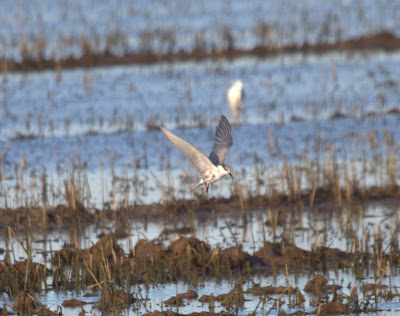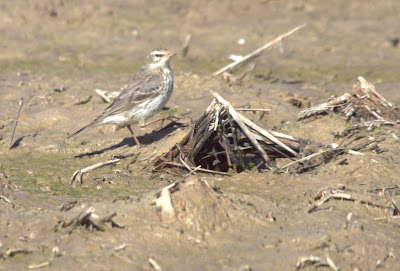I’d arrived in Alicante on the evening of the 22 Feb and met
up with my sister and her family to go to the Valencia v Stoke City Europa
League game, the main reason for me being out in Spain in the first place. I
had a chance to get half an hours birding in before we had to head off to
Valencia, so I made for the headland just north of the port. I was hoping to
see some seabirds, but apart from a few Gannets, there was little of note. The
best birds were passerines on the rocky outcrops on the headland, the prime one
being a Black Wheatear, something that had evaded me in the interior. Lots of
Serins also buzzed around the headland making a welcome distraction from the
rather empty sea.
 |
| Serin |
 |
| Black Wheatear |
The journey up to Valencia was fairly birdless and Stoke
lost 1-0 (2-0 on aggregate) meaning the end of Stoke’s European adventure for a
few years probably. It was good whilst it lasted though.
The next day (24 Feb) I spent the day around Parc Natural
de l’Albufera. This large natural lagoon sits about 500 metres from the sea and
is about 3km by 2km in size. Unfortunately, the main reserve was having
maintenance work done on it and all the birds had been disturbed. The warden
said that it was unlikely that any birds would return that day, so he kindly
drew me a map of other good sites for me to visit and left the hide. I then
looked out onto what had been a birdless scrape when I arrive to find a
pale-phased Booted Eagle sat on the island, pulling away at sticks and straw that
had been cut up by the reserve maintenance staff. The bird put on a really good
show before heading off to the main lagoon.
| Booted Eagle - pale phase |
 |
| Booted Eagle - pale phase |
 |
| Booted Eagle - pale phase |
 |
| Booted Eagle - pale phase |
 |
| Booted Eagle - pale phase |
 |
| Booted Eagle - pale phase |
 |
| Booted Eagle - pale phase |
| Crag Martin |
| Crag Martin |
 |
| Sandwich Tern |
I spent the rest of the day driving
around looking for wet rice paddys. The area to the south of the lagoon was
very rich in birds with the best area having around 1000 Black-tailed Godwits,
a similar number of Golden Plover, Lapwings, Ruff, Dunlin and Common Snipe. A
Spotted Crake fed right out in the open on a muddy rice paddy and Bluethroats
were quite common near reedy areas. Other birds included lots of Crag Martins,
Purple Swampens (which I think are introduced), and Penduline Tit. To the south
near the village of El Perello a little sea inlet held up to 13 adult Audouin’s
Gulls plus smaller number of Yellow-legged Gull. Nearby, I came over a flock of
Chiffchaffs feeding on a road. There were about 50 birds feeding on small gnats
that were frequenting some roadside ditches and reed strands and the
Chiffchaffs were gorging themselves on them. On my way back to Valencia I made
a detour to look at the area where the lagoon is fed by the river at the north
of the lagoon and I wasn’t disappointed. I found a large area of flooded rice
paddy where the farmers were ploughing and there were thousands of gulls and
egrets feeding here. There were probably 5000 Black-headed, 2000 Lesser
Black-backed and a few hundred Yellow-legged Gulls. There were quite a few
waders too – Black-winged Stilts, Greenshank, Spotted Redshank and Ruff all fed
together and 2 Audouin’s Gulls, 3 Eurasian Spoonbill and a winter plumaged Whiskered Tern also put in
an appearance. It was a fine way to sign off what had been a great birding trip
(despite the football score) and brought my trip total to 131 species.
 |
| Black-tailed Godwit |
 |
| Great White Egret |
 |
| Purple Swamphen |
 |
| Bluethroat |
 |
| Bluethroat |
 |
| Chiffchaffs |
Chiffchaff
 |
| Chiffchaff |
 |
| Black Redstart |
 |
| Little Egret |
 |
| Little Egret |
 |
| Whiskered Tern |
 |
| Audouin's Gulls |
 |
| Audouin's Gull |
 |
| Audouin's Gull |
| Audouin's Gull |






















